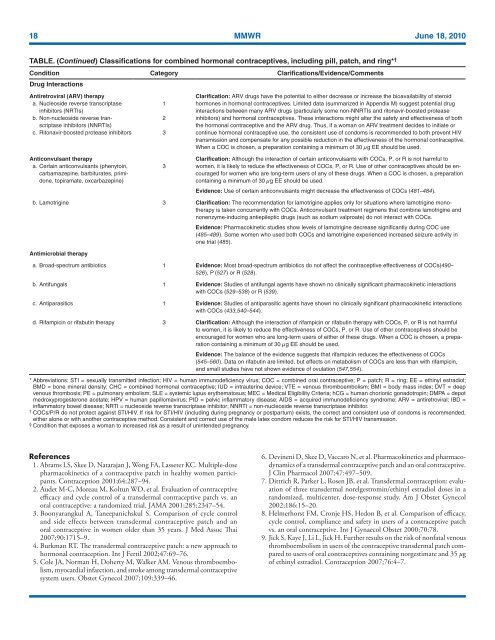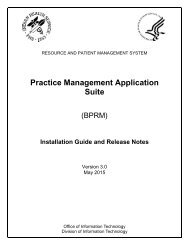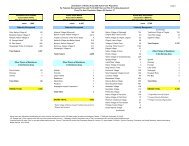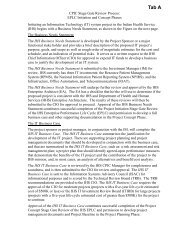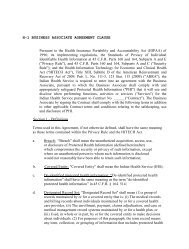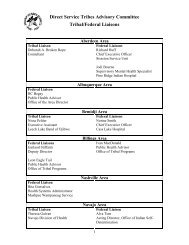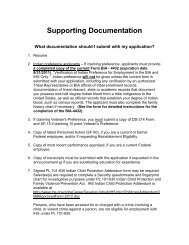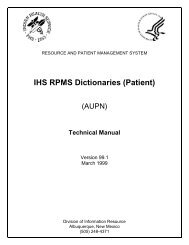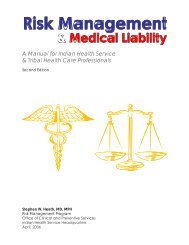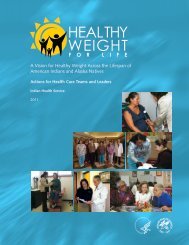CDC Article-US Medical Eligibility Criteria for Contraceptive Use, 2010
CDC Article-US Medical Eligibility Criteria for Contraceptive Use, 2010
CDC Article-US Medical Eligibility Criteria for Contraceptive Use, 2010
Create successful ePaper yourself
Turn your PDF publications into a flip-book with our unique Google optimized e-Paper software.
18 MMWR June 18, <strong>2010</strong><br />
TABLE. (Continued) Classifications <strong>for</strong> combined hormonal contraceptives, including pill, patch, and ring* †<br />
Condition Category Clarifications/Evidence/Comments<br />
Drug Interactions<br />
Antiretroviral (ARV) therapy<br />
a. Nucleoside reverse transcriptase<br />
1<br />
inhibitors (NRTIs)<br />
b. Non-nucleoside reverse transcriptase<br />
inhibitors (NNRTIs)<br />
2<br />
c. Ritonavir-boosted protease inhibitors 3<br />
Clarification: ARV drugs have the potential to either decrease or increase the bioavailability of steroid<br />
hormones in hormonal contraceptives. Limited data (summarized in Appendix M) suggest potential drug<br />
interactions between many ARV drugs (particularly some non-NNRTIs and ritonavir-boosted protease<br />
inhibitors) and hormonal contraceptives. These interactions might alter the safety and effectiveness of both<br />
the hormonal contraceptive and the ARV drug. Thus, if a woman on ARV treatment decides to initiate or<br />
continue hormonal contraceptive use, the consistent use of condoms is recommended to both prevent HIV<br />
transmission and compensate <strong>for</strong> any possible reduction in the effectiveness of the hormonal contraceptive.<br />
When a COC is chosen, a preparation containing a minimum of 30 µg EE should be used.<br />
Anticonvulsant therapy<br />
a. Certain anticonvulsants (phenytoin,<br />
carbamazepine, barbiturates, primidone,<br />
topiramate, oxcarbazepine)<br />
3<br />
Clarification: Although the interaction of certain anticonvulsants with COCs, P, or R is not harmful to<br />
women, it is likely to reduce the effectiveness of COCs, P, or R. <strong>Use</strong> of other contraceptives should be encouraged<br />
<strong>for</strong> women who are long-term users of any of these drugs. When a COC is chosen, a preparation<br />
containing a minimum of 30 µg EE should be used.<br />
Evidence: <strong>Use</strong> of certain anticonvulsants might decrease the effectiveness of COCs (481–484).<br />
b. Lamotrigine 3 Clarification: The recommendation <strong>for</strong> lamotrigine applies only <strong>for</strong> situations where lamotrigine monotherapy<br />
is taken concurrently with COCs. Anticonvulsant treatment regimens that combine lamotrigine and<br />
nonenzyme-inducing antiepileptic drugs (such as sodium valproate) do not interact with COCs.<br />
Evidence: Pharmacokinetic studies show levels of lamotrigine decrease significantly during COC use<br />
(485–489). Some women who used both COCs and lamotrigine experienced increased seizure activity in<br />
one trial (485).<br />
Antimicrobial therapy<br />
a. Broad-spectrum antibiotics 1 Evidence: Most broad-spectrum antibiotics do not affect the contraceptive effectiveness of COCs(490–<br />
526), P (527) or R (528).<br />
b. Antifungals 1 Evidence: Studies of antifungal agents have shown no clinically significant pharmacokinetic interactions<br />
with COCs (529–538) or R (539).<br />
c. Antiparasitics 1 Evidence: Studies of antiparasitic agents have shown no clinically significant pharmacokinetic interactions<br />
with COCs (433,540–544).<br />
d. Rifampicin or rifabutin therapy 3 Clarification: Although the interaction of rifampicin or rifabutin therapy with COCs, P, or R is not harmful<br />
to women, it is likely to reduce the effectiveness of COCs, P, or R. <strong>Use</strong> of other contraceptives should be<br />
encouraged <strong>for</strong> women who are long-term users of either of these drugs. When a COC is chosen, a preparation<br />
containing a minimum of 30 µg EE should be used.<br />
Evidence: The balance of the evidence suggests that rifampicin reduces the effectiveness of COCs<br />
(545–560). Data on rifabutin are limited, but effects on metabolism of COCs are less than with rifampicin,<br />
and small studies have not shown evidence of ovulation (547,554).<br />
* Abbreviations: STI = sexually transmitted infection; HIV = human immunodeficiency virus; COC = combined oral contraceptive; P = patch; R = ring; EE = ethinyl estradiol;<br />
BMD = bone mineral density; CHC = combined hormonal contraceptive; IUD = intrauterine device; VTE = venous thromboembolism; BMI = body mass index; DVT = deep<br />
venous thrombosis; PE = pulmonary embolism; SLE = systemic lupus erythematosus; MEC = <strong>Medical</strong> <strong>Eligibility</strong> <strong>Criteria</strong>; hCG = human chorionic gonadotropin; DMPA = depot<br />
medroxyprogesterone acetate; HPV = human papillomavirus; PID = pelvic inflammatory disease; AIDS = acquired immunodeficiency syndrome; ARV = antiretroviral; IBD =<br />
inflammatory bowel disease; NRTI = nucleoside reverse transcriptase inhibitor; NNRTI = non-nucleoside reverse transcriptase inhibitor.<br />
†<br />
COCs/P/R do not protect against STI/HIV. If risk <strong>for</strong> STI/HIV (including during pregnancy or postpartum) exists, the correct and consistent use of condoms is recommended,<br />
either alone or with another contraceptive method. Consistent and correct use of the male latex condom reduces the risk <strong>for</strong> STI/HIV transmission.<br />
§<br />
Condition that exposes a woman to increased risk as a result of unintended pregnancy.<br />
References<br />
1. Abrams LS, Skee D, Natarajan J, Wong FA, Lasseter KC. Multiple-dose<br />
pharmacokinetics of a contraceptive patch in healthy women participants.<br />
Contraception 2001;64:287–94.<br />
2. Audet M-C, Moreau M, Koltun WD, et al. Evaluation of contraceptive<br />
efficacy and cycle control of a transdermal contraceptive patch vs. an<br />
oral contraceptive: a randomized trial. JAMA 2001;285:2347–54.<br />
3. Boonyarangkul A, Taneepanichskul S. Comparison of cycle control<br />
and side effects between transdermal contraceptive patch and an<br />
oral contraceptive in women older than 35 years. J Med Assoc Thai<br />
2007;90:1715–9.<br />
4. Burkman RT. The transdermal contraceptive patch: a new approach to<br />
hormonal contraception. Int J Fertil 2002;47:69–76.<br />
5. Cole JA, Norman H, Doherty M, Walker AM. Venous thromboembolism,<br />
myocardial infarction, and stroke among transdermal contraceptive<br />
system users. Obstet Gynecol 2007;109:339–46.<br />
6. Devineni D, Skee D, Vaccaro N, et al. Pharmacokinetics and pharmacodynamics<br />
of a transdermal contraceptive patch and an oral contraceptive.<br />
J Clin Pharmacol 2007;47:497–509.<br />
7. Dittrich R, Parker L, Rosen JB, et al. Transdermal contraception: evaluation<br />
of three transdermal norelgestromin/ethinyl estradiol doses in a<br />
randomized, multicenter, dose-response study. Am J Obstet Gynecol<br />
2002;186:15–20.<br />
8. Helmerhorst FM, Cronje HS, Hedon B, et al. Comparison of efficacy,<br />
cycle control, compliance and safety in users of a contraceptive patch<br />
vs. an oral contraceptive. Int J Gynaecol Obstet 2000;70:78.<br />
9. Jick S, Kaye J, Li L, Jick H. Further results on the risk of nonfatal venous<br />
thromboembolism in users of the contraceptive transdermal patch compared<br />
to users of oral contraceptives containing norgestimate and 35 µg<br />
of ethinyl estradiol. Contraception 2007;76:4–7.


